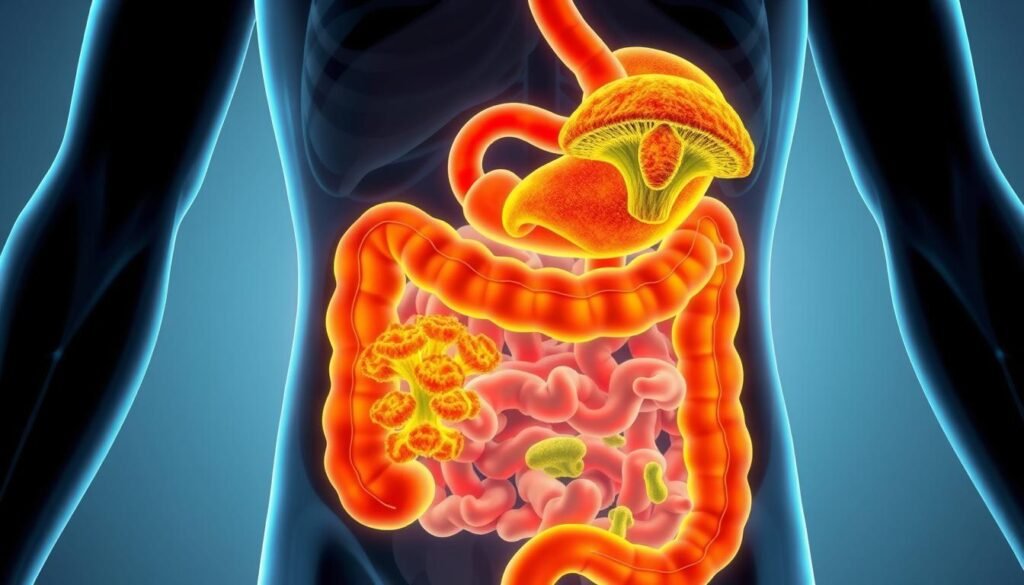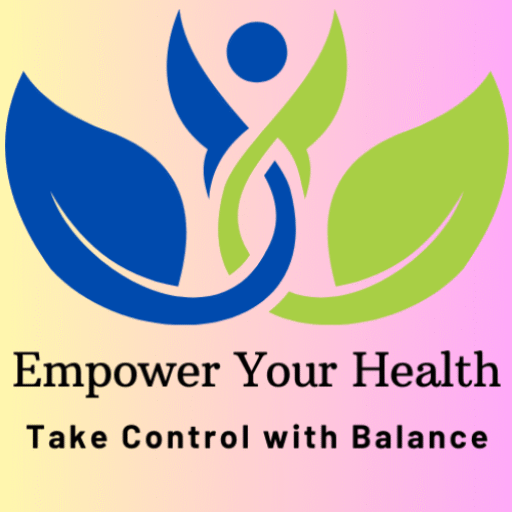Ever had persistent yeast infections or unexplained digestive issues? These could be common candidiasis symptoms, a common but often misunderstood condition. But how do you spot the symptoms? Learn about this health issue and take charge of your health.

Table of Contents
Key Takeaways
- Candidiasis is a fungal infection caused by an overgrowth of Candida, a type of yeast that naturally resides in the body.
- Common symptoms of candidiasis include oral thrush, skin rashes, digestive problems, and vaginal yeast infections.
- Understanding the various manifestations of candidiasis can help you identify the condition and seek appropriate treatment.
- Recognizing the early signs of candidiasis is crucial for preventing the infection from worsening and causing more severe health complications.
- Seeking medical attention is advisable if you suspect you may be experiencing candidiasis symptoms, as proper diagnosis and management are essential.
Understanding Candidiasis and Its Impact on Health
Candidiasis, also known as a yeast infection, is a common fungal overgrowth. It’s caused by the Candida albicans fungus. This fungus can grow in different parts of the body, causing health problems. Knowing the causes, risk factors, and types of candidiasis is key to treating it.
What Causes Candida Overgrowth?
Candida overgrowth can happen for several reasons:
- Disruption of the body’s natural microbiome balance
- Weakened immune system
- Excessive use of antibiotics or corticosteroids
- Poor dietary choices, such as a high-sugar or high-carb diet
- Stress and hormonal imbalances
Risk Factors for Developing Candidiasis
Some people are more likely to get candidiasis because of:
- Diabetes or other chronic health conditions
- Pregnancy
- Recent antibiotic use
- Poor personal hygiene or clothing choices
- Weakened immune system due to medication or illness
Types of Candida Infections
Candidiasis can show up in different ways, including:
- Oral thrush
- Vaginal yeast infections
- Skin and nail fungal infections
- Gastrointestinal issues
- Systemic or invasive candidiasis, which can affect multiple organs
It’s important to know the causes, risk factors, and types of candidiasis. This helps spot the fungal overgrowth indicators and candida albicans symptoms early.
Candidiasis Symptoms: Key Signs to Watch For
Candidiasis, also known as thrush, can show many symptoms across the body. Knowing the common signs is key for quick diagnosis and treatment. Let’s look at the main candidiasis symptoms to watch out for.
One common symptom is white, cottage cheese-like discharge from the mouth, vagina, or other areas. This discharge often comes with itching, burning, or irritation in the affected area.
People with candidiasis may also see redness, swelling, or cracked skin in the affected areas. This can cause discomfort, pain, and make daily tasks hard.
- Persistent fatigue and lethargy
- Recurrent yeast infections or thrush
- Digestive issues such as bloating, gas, or constipation
- Skin conditions like eczema, psoriasis, or rashes
- Frequent urinary tract infections (UTIs)
The symptoms of candidiasis can vary based on the type and location of the infection. Getting medical help quickly is important for a correct diagnosis and treatment.
“Recognizing the early signs of candidiasis can make all the difference in managing the infection effectively.”
By staying alert to candidiasis symptoms, people can take steps to keep their health in check.
Oral Thrush: Recognizing Mouth and Throat Signs
Oral candidiasis, also known as oral thrush, is a common condition. It affects the mouth and throat. Knowing the symptoms is key for quick diagnosis and treatment. Let’s look at the main signs of oral thrush.
White Patches and Soreness
White, creamy patches on the tongue, cheeks, gums, or roof of the mouth are a clear sign. These patches feel velvety or like cottage cheese. They can also be sore and painful.
Difficulty Swallowing
As the infection grows, it can irritate the throat. This makes swallowing hard and uncomfortable. It can affect eating and drinking, impacting daily life.
Changes in Taste Sensation
Oral thrush can change how things taste. Some people might taste metal, bitterness, or even nothing at all. This can make eating and drinking less enjoyable.
If you notice these oral candidiasis symptoms or thrush manifestations, see a doctor right away. Quick action can ease discomfort and stop the infection from getting worse.
Skin Manifestations of Candida Infections
Candida infections, also known as yeast infections, can show up in different ways on the skin. These candida rash symptoms and yeast infection signs can be anything from mild irritation to serious skin problems.
A common sign of candida is a red, itchy rash. This candida rash often pops up in moist spots like the armpits, groin, or under the breasts. Sometimes, the rash can spread and get worse, causing pain and looking bad.
Another sign of candidiasis is intertrigo, a rash in skin folds. It looks like red, raw skin with a strong smell. Intertrigo is a big problem in places where skin rubs together, like the inner thighs or under the breasts.
Candida can also cause nail fungal infections. This makes nails thick, yellow, or brittle. Onychomycosis is hard to treat and can look and feel bad.
In serious cases, candidiasis can cause a full-body rash with blisters or peeling skin. This needs quick medical help because it might mean a bigger health problem.
| Skin Manifestation | Description |
|---|---|
| Candida Rash | Red, itchy rash in moist areas like the armpits, groin, or under the breasts |
| Intertrigo | Red, raw-looking rash in skin folds, often with a distinct odor |
| Nail Fungal Infection (Onychomycosis) | Thick, yellow, or brittle nails |
| Systemic Candidiasis Rash | Widespread, full-body rash with blisters or peeling skin |
If you notice any of these candida rash symptoms or yeast infection signs, get medical help. They can help figure out and treat the candidiasis.
Vaginal Yeast Infections: Common Indicators
Vaginal yeast infections, also known as vaginal candidiasis, are common among women. It’s important to know the symptoms to get treatment quickly.
Discharge Changes
A change in vaginal discharge is a key sign. The discharge may become thicker, whiter, and look like cottage cheese. It might also smell yeasty or slightly sweet.
Discomfort and Irritation
Vaginal yeast infections can cause itching, burning, and redness. They can also make sex painful or uncomfortable.
Associated Symptoms
- Swelling or inflammation of the vulva
- Redness or rawness of the vaginal tissue
- Pain or discomfort when urinating
These symptoms can also mean other health issues. It’s key to see a doctor for a correct diagnosis and treatment.
| Symptom | Description |
|---|---|
| Vaginal Discharge | Thick, white, and cottage cheese-like in appearance, with a yeasty or slightly sweet odor. |
| Itching and Irritation | Intense itching, burning, and redness in the vaginal and vulvar area, often worse during sexual activity. |
| Associated Symptoms | Swelling or inflammation of the vulva, redness or rawness of the vaginal tissue, and pain or discomfort when urinating. |
Knowing the vaginal candidiasis symptoms and getting medical help fast is key to managing vaginal yeast infections.
Digestive System Signs of Candida Overgrowth
Candidiasis is a fungal infection caused by Candida albicans yeast. It can greatly affect the digestive system. An overgrowth of this fungus leads to uncomfortable symptoms in the gut.
Bloating is a common sign of fungal overgrowth indicators. Feeling full or distended in the abdomen is a clear sign. Candida albicans symptoms also include chronic constipation or diarrhea, as the body tries to maintain bowel function.
- Abdominal bloating and gas
- Chronic constipation
- Recurrent diarrhea
The imbalance caused by candida albicans can lead to other issues. These include heartburn, indigestion, and food sensitivities. The fungus can also make it hard to digest and absorb nutrients, causing malabsorption and nutritional deficiencies.
“Candidiasis can wreak havoc on the digestive system, causing a wide range of uncomfortable and disruptive symptoms.”
If you have ongoing digestive problems, see a healthcare professional. They can check if candida albicans is the cause. Treating the fungal overgrowth can help balance the gut and ease symptoms.

Systemic Candidiasis: Recognizing Serious Symptoms
Candidiasis can turn into a serious condition called systemic candidiasis if it spreads. At this stage, candidiasis symptoms can affect many parts of the body. This can be very dangerous and even life-threatening.
Widespread Internal Signs
People with systemic candidiasis may have many concerning symptoms. These include:
- Chronic fatigue and weakness
- Unexplained muscle and joint pain
- Recurring headaches or migraines
- Difficulty concentrating or memory issues
- Recurring respiratory infections or pneumonia
- Fever, chills, and night sweats
Emergency Warning Signals
Systemic candidiasis symptoms can get worse fast and need quick medical help. Don’t ignore these warning signs:
- Sudden organ dysfunction, such as liver or kidney failure
- Severe abdominal pain or gastrointestinal bleeding
- Difficulty breathing or chest pain
- Altered mental state, confusion, or disorientation
- Sudden and unexplained weight loss
These candidiasis symptoms are serious and need fast treatment. They can lead to organ failure or sepsis if not treated right away.
It’s very important to know how serious systemic candidiasis is. It can get worse fast and cause serious problems. If you see these warning signs, get medical help right away. This can help you get the treatment you need to manage this serious condition.
Male-Specific Candida Infection Symptoms
While yeast infection signs are common in women, men can get them too. It’s important to know how this looks in men to get the right treatment fast.
Men often see a red, itchy rash on their penis. This rash might have a white, cheesy look. It can hurt when you pee or have sex.
Men might also notice other signs, like:
- Redness and irritation in the groin or inner thighs
- Persistent jock itch or athlete’s foot
- Difficulty keeping an erection or early ejaculation
- Less interest in sex or trouble performing
These signs might mean you have a candidiasis infection. But they could also mean something else. Always see a doctor to find out for sure.
| Common Male Candidiasis Symptoms | Potential Causes |
|---|---|
| Genital rash and discharge | Yeast overgrowth, poor hygiene, tight-fitting clothing |
| Groin and inner thigh irritation | Friction, poor hygiene, heat and moisture buildup |
| Sexual performance issues | Candida-related inflammation, psychological factors |
If you see any of these candidiasis symptoms, see a doctor right away. They can help stop the infection from getting worse and make you feel better.

When to Seek Medical Attention for Candidiasis
Dealing with candidiasis can be tough. It’s key to know when to see a doctor for your health. Some symptoms might be handled with over-the-counter treatments. But, there are times when you need a healthcare professional’s help.
Severe Symptoms Requiring Immediate Care
If you have severe candidiasis symptoms, get medical help fast:
- High fever or chills
- Severe abdominal pain or nausea
- Difficulty swallowing or breathing
- Widespread, painful skin rashes
- Signs of a systemic infection, such as lethargy or confusion
Chronic Infection Indicators
Some candidiasis symptoms may come and go. But, don’t ignore fungal overgrowth indicators that keep coming back. If you have chronic symptoms, see your healthcare provider:
- Recurring vaginal yeast infections
- Persistent digestive issues, such as bloating or diarrhea
- Unexplained fatigue or brain fog
- Frequent skin rashes or infections
- Recurrent oral thrush or white patches in the mouth
Early detection and treatment are crucial for managing candidiasis symptoms. Don’t wait to get medical help if you’re worried about your health.
Understanding Candida Die-Off Reactions
Treating candidiasis can sometimes lead to “candida die-off” or the Herxheimer reaction. This happens when treatment starts to work, causing candida fungi to die quickly. This releases toxins into the body. While it shows the treatment is working, these toxins can make symptoms worse temporarily.
The symptoms of candida die-off can be uncomfortable. They may include:
- Fatigue and brain fog
- Headaches and dizziness
- Nausea, bloating, and digestive discomfort
- Skin rashes, itching, or breakouts
- Joint and muscle pain
- Increased candida infection symptoms, such as thrush or vaginal yeast infections
It’s important to tell die-off symptoms apart from ongoing candida infections. Die-off symptoms usually show up in the first few days or weeks of treatment. Ongoing infection symptoms may last longer and get worse.
Managing candida die-off is key to keep progress and reduce discomfort. You might need to adjust your treatment, add supplements, or practice self-care. Working with a healthcare professional can help you recover smoothly from candidiasis.
“Understanding the candida die-off process can help you navigate the temporary discomfort and stay focused on the long-term goal of regaining optimal health.”
Conclusion
Understanding candidiasis symptoms is key to getting help fast. This common fungal infection shows itself in many ways. From oral thrush to skin rashes, knowing these signs helps you get the right care.
If you’re dealing with vaginal yeast infections, digestive problems, or other symptoms, don’t ignore them. Seeing a doctor is crucial. They can figure out what’s wrong and help you get better.
Knowing about candidiasis symptoms and acting early can help keep you healthy. It stops complications from untreated infections. Early action and treatment are vital for managing this condition well.
FAQ
What are the most common symptoms of candidiasis?
Common symptoms include white patches in the mouth (oral thrush) and vaginal yeast infections. You might also see rashes or skin irritation. Digestive issues like bloating or constipation are also signs.
How can I identify the signs of oral thrush?
Oral thrush shows as white patches on the tongue, cheeks, or gums. You might feel sore, have trouble swallowing, or taste changes.
What are the common symptoms of a vaginal yeast infection?
Vaginal yeast infections have thick, chunky discharge and intense itching. You might also feel pain during sex.
Can candidiasis affect the skin?
Yes, it can cause red, itchy rashes. These often appear in moist areas like the armpits, groin, or under the breasts.
What are the signs of systemic candidiasis?
Systemic candidiasis can cause fever, chills, and muscle aches. It can also affect organs and needs immediate medical help.
How can I tell if my candidiasis symptoms are part of a die-off reaction?
Die-off symptoms include flu-like feelings, headaches, and fatigue. They usually get better as your body adjusts to treatment.
When should I see a doctor about my candidiasis symptoms?
See a doctor for severe or lasting symptoms like high fever or trouble swallowing. Also, if symptoms don’t get better with over-the-counter treatments. Chronic or recurring infections need professional help.




The articles you write help me a lot and I like the topic http://www.ifashionstyles.com
Valuable information. Lucky me I found your website by accident, and I am shocked why this accident did not happened earlier! I bookmarked it.
Thank you very much, your messages keep my courage up and give me more motivation to continue my work. Thank you very much for your encouragement.
Hi, Neat post. There is a problem with your website in internet explorer, would check this?IE still is the market leader and a large portion of people will miss your excellent writing due to this problem.
Generally I do not read post on blogs, but I would like to say that this write-up very forced me to try and do it! Your writing style has been surprised me. Thanks, quite nice article.